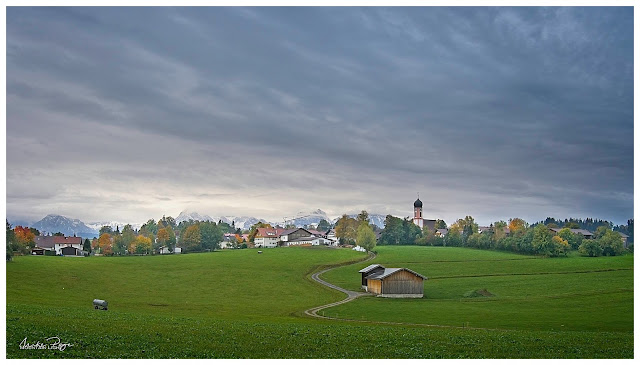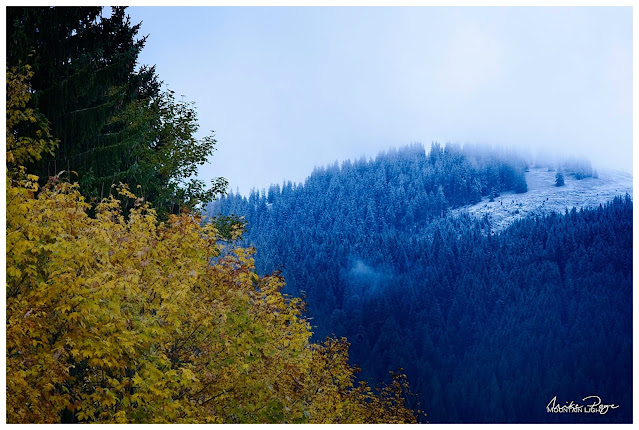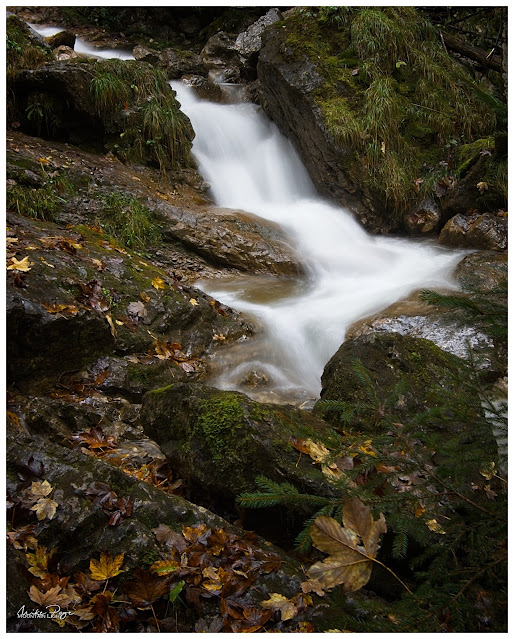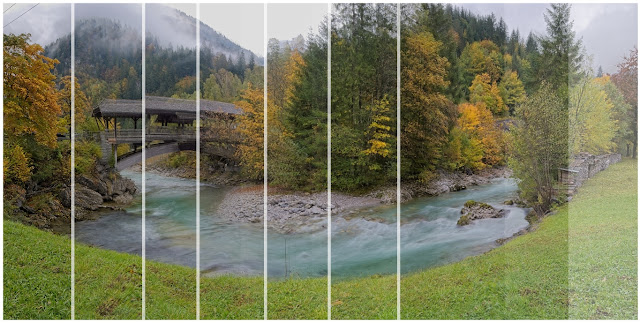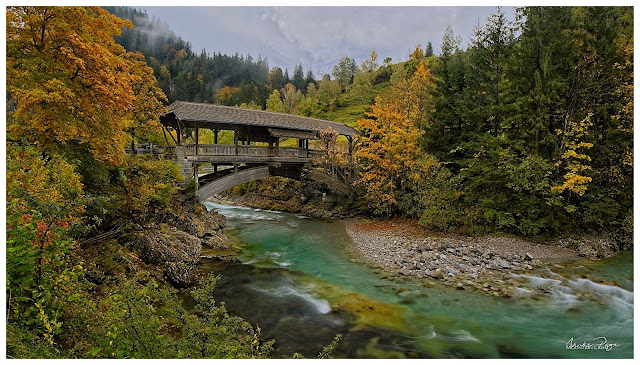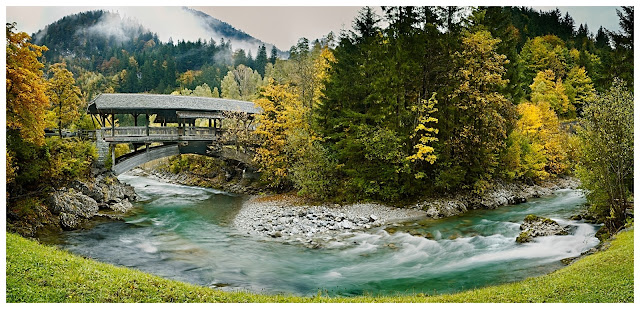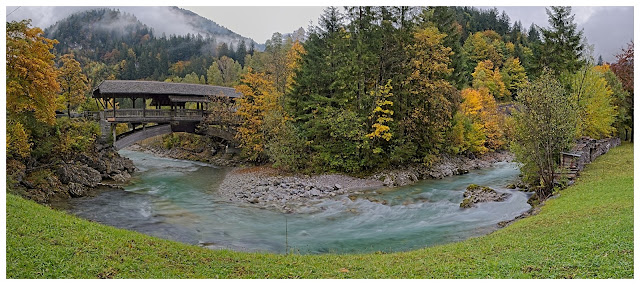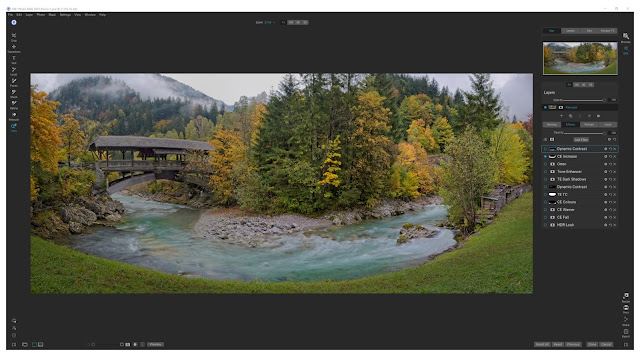Saturday saw us in one of the local gorges looking for compositions in the snow again. In today's blog I go into a lot of detail concerning the thought processes and relevant settings behind each of the images and was pleasantly surprised just how much is going on - a lot of it is second nature. Hope you enjoy.
 |
| Beeches and Birches I || Olympus 18 mm, f/8, 1/60 s, ISO 800 |
This was essentially an instinct shot - we were walking up the path above the gorge towards the Purschlinghaus - an excellent excursion on another occasion or at another time - and this scene manifested on our right just before a bridge. I made a note of it at the time because I thought it had potential and got this snapshot off. What caught my attention were the silver birch trunks, beech saplings and the stream behind - that you can't really see here. The tones were just so harmonious that they were screaming to be taken. Even though this was an instinct shot and the better composition had to be worked a little (see below), I'm quite happy with this as a stand alone image. Normally I try to stick to the camera's native ISO of 200, but I set it on auto today as it was quite overcast. One of the downsides to higher ISOs, particularly on smaller sensor cameras like mine, is that the image can become unappealingly noisy or grainy. I wasn't too concerned about this happening in the snow, however, as this would mask a lot of that problem.
There's a 2005 German folk song that goes something like this:
"Ob er aber über Oberammergau Oder aber über Unter-ammergau Oder aber überhaupt nicht kommt. Des ist net g'wiss"
- freely translated: "it's uncertain whether he'll come via Oberammergau or Unterammergau, or whether he'll come at all". It does loose something in translation though. What remains is the fact that Oberammergau and Unterammergau both have their own unique charm. Oberammergau, home to the world-famous Passion Play celebrating the end of the 17th century plague by retelling the story of the Passion of Christ, is quintessentially Bavarian but very touristic. It's less well known cousin, Unterammergau, is just 5 km down the road but still very much worth a visit, not least of which for a trip to the Schleifmühlklamm - the whetstone mill gorge. In other times the eponymous restaurant is also worth a visit, though for obvious reasons it's presently closed.
Smaller and less well known that, say, the Partnach or Höhlental gorges in nearby Garmisch, the Schleifmühlklamm is still very much worth a visit and has two or three waterfalls that are a photographer's delight. We'd recently equipped ourselves with ice spikes for our hiking boots and I was also keen to try out my newly acquired Vallarret photography gloves. They're regular winter gloves with removable tips for the index fingers and thumbs allowing camera operation in cold weather. Not cheap, but definitely effective.
 |
| Our new Grivel spikes || Olympus |
I want to spend a bit of time in today's post talking about photographic decisions and reasons for certain compositions. The above photo is a great place to start, even though it's pretty much a "B-roll" shot - it was a spontaneous candid and the camera was still in exposure bracketing mode. I knew wanted a slower shutter speed for this shot but also knew that I didn't have time to change to shutter priority mode, select a lower shutter speed, frame up and shoot, so it was literally a grab shot. I had three exposures, 2 EV apart. I could easily have chosen the first shot, though the movement wouldn't have been quite as pronounced. Instead I've gone for the slower, high exposure shot, giving motion blur as well as isolating the element that I want the viewer to be looking at - in this case the spikes. It helps that they're yellow and there are two pairs of them. Normally the eyes drift to light objects in a scene, but this is trumped by contrast. If the whole scene is bright, then the eyes drift to something else, in this case the bright spikes.
The sign at the bottom of the gorge stated explicitly no admittance due to the icy conditions, though the sign turned out to be a little superfluous in light of recent snowfalls. I would definitely not recommend hiking through the gorge in the winter without some sort of grip-enhancer however. There are places that would be impassable if it were icy.
 |
| The Stream || Olympus |
As we were walking my eye was caught by this slash of stream showing through the snow. Because it had been very cold, ice had formed over parts of the water which had then become covered in snow. This short section of exposed stream caught my eye because it was discrete - closed at both ends - and isolated. The almost parallel lines of the banks, the fact that the whole section was open and not interrupted and the branches giving a bit of texture contrast meant that I couldn't pass this shot up. It's a hand-held HDR - otherwise the water would just have been a black gash or the snow a white gunk. It's got abstract quality, but the branches and leaves anchor it in reality.
Having been here a number of times over the years I knew which spots I wanted to visit in the gorge, but my eyes were open for new compositions as well. Winter changes the landscape as I've mentioned before. Things that work in the summer might not in the winter, messy scenes might suddenly work under a blanket of snow, some vantage points might not be accessible any more and, well, ICE!
 |
| Frozen Falls || Olympus 14 mm, f/16, 1/4 s, ISO 200 |
This is the first easily accessible waterfall - you have to branch right off the path to get to this point. I tried a couple of angles for this shot; there was a snow covered stone standing proud of the water that disturbed me and so I tried a lower angle, but that made the pool at the bottom too thin, so I went for the original composition and stamped the stone out in post. There are a couple of things I really like about this composition; the snow focusses the attention on the main actors, whereas in the summer there is a lot more rock competing for the eye. Also, the rock that does remain provides a nice set of lines pointing to the action. The green of the water and the orange-brown of the rock complement each other nicely and obviously I've chosen a longer exposure to emphasise the motion of the water. The low aperture was partly in order to achieve the desired shutter speed, partly to increase the depth of field. I focused on the rock next to the waterfall. Although it wouldn't ruin the shot if the foreground snowbank wasn't pin sharp, I wanted all the rock and the forest beyond to be in focus. The waterfall was as good as 1/3 of the way into the scene as I could find, plus at 14 mm AND m43, depth of field wasn't going to be an issue here.
Compositionally I could have cropped down to just the waterfall, but I wanted to include some of the environment. There's even a bit of sky at the top of the image, normally a no-no when photographing waterfalls, but a bit more white doesn't disturb the flow. I also tried an HDR version of this shot, but in the end was happy with the dynamic range I was able to winkle out of this single exposure.
 |
| Snow Family || Olympus 21 mm, f/8, 1/60 s, ISO1000 |
My daughter got bored waiting for me to take the previous shot and so made herself a little snowman family.
The next waterfall is tricky, particularly in the winter because the narrow path opposite traverses a steep slope. Finding a good vantage point for the waterfall where I could set up the tripod stably was not easy. Fortunately I wasn't disturbed as I was taking these shots - had I been so I would have had to lift up the tripod out of the way and then set up the shot again.
 |
| Upper Falls I: HDR || Olympus 14 mm, f/5.6, 2 s, ISO 200 |
 |
| Upper Falls II || Olympus 14 mm, f/7.1, 2 s, ISO 200 |
This one's tricky. I ended up taking two images, one landscape, which I cropped to 1:1 and made an HDR image of (top), the other a single exposure in portrait format. Both have things I like about them. In the top image, for example, I really like the rock face and the way the viewer's attention is drawn to the water coming out of a cave almost. In the second shot I like the addition of the green fir trees, the inclusion of the bridge and the symmetry afforded by the waterfall and the gap above it. However, the second image isn't sharp. The snow was soft and I think I must have disturbed the tripod a little.
The climb out of the gorge takes you up a steep path up a series of steps and bridges like the one above. In icy conditions, this would be the impossible bit without spikes. There's a hand rail for assurance for the most exposed parts, but in the snow this was more of a knee rail. The path then comes out on the forest track that doubles as a sledging run in the winter, a trail that we've used a couple of times and is great fun.
I've deliberately left this - and many of the other images here - high key, with most of the tones in the light half of the spectrum rather than spread over the whole tonal range from dark as this best reflects the bright scenery in the snow. I love the pale browns and greens with the frosted edges.
 |
| Four Friends || Olympus 66 mm, f/10, 1/80 s, ISO 1600 |
Following the path upwards, it was just a question of keeping the eyes open for further images.
What struck me here was the series of repetitive elements. Tessellation is a powerful structural part of images, whether perfect as with man-made structures or natural with imperfections such as here. I had to get in close to isolate this set of branches, hence the focal length of 100 mm - the longest I can go with my 12-100 mm Zuiko lens.
The backdrop is what caught my eye here, the various trees in the snow going from the firs behind the people through the brown birches and firs at the top. The family group added a human touch to an otherwise cold scene, accentuated by the bright colours of their clothes.
And then we had to turn home. I was itching to have a second go at the birches and beeches scene as I was sure that there was a strong composition to be had if only I could find the right angle. I wanted to catch the orange of the beech leaves as well as the stream behind, but from most angles I could either have one or the other. Getting closer to the trees let me have more view of the stream, but the thing that had grabbed my attention, insisting that I had a second go at the scene, was the combination of the leaves and the stream. It was a question of getting it all aligned perfectly for a really strong image.
 |
| Beeches and Birches II || Olympus 34 mm, f/16, 1/25 s, ISO 1600 |
This was the third attempt at the scene after I noticed an intrusive stump that you'll see to the left of the very first image. Here I've put more of the stream in the scene - this was what had caught my eye through the leaves due to the similarity in colour. Another consideration here was whether or not to include the base of the trees - something that I'd done in the first shot but not here as I'd gone closer to the trees. Hence the low aperture again. I was focussing on the trees and didn't want to lose depth of field at the log weir at the back.
 |
| Beeches and Birches III || Olympus 35 mm, f/16, 1/30 s, ISO 1600 |
I've surprised myself at how much thought goes into each photo in the field. Much of it has become second nature so I don't really think about it - it's almost instinct, but it's definitely interesting to go through the process and analyse what considerations were driving each individual shot. Anyway, I hope you enjoy them and call back next time.

















